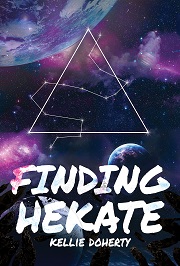Writing Tiny: A Look Into Flash Fiction
 Plot, characterization, structure, hook. These are buzzwords for writers everywhere, words we live and breath, ideas we sacrifice hours of our lives toward (and maybe even a few tears) just so we can craft the perfect story. We agonize over each paragraph and chapter, and we probably use hundreds of pages while doing so. When I think about these big, bold buzzwords, I tend to think about big, bold books—novel-length works—but what about the little guys? What about, say, flash fiction?
Plot, characterization, structure, hook. These are buzzwords for writers everywhere, words we live and breath, ideas we sacrifice hours of our lives toward (and maybe even a few tears) just so we can craft the perfect story. We agonize over each paragraph and chapter, and we probably use hundreds of pages while doing so. When I think about these big, bold buzzwords, I tend to think about big, bold books—novel-length works—but what about the little guys? What about, say, flash fiction?
Flash fiction is quite short—it can range from 1,000 words to just 6—and there are so many different forms that any writer can find one suited to their tastes. For example, for those who really love brevity, the six-word story is literally six words long; for social buffs, try out the twitterature which is made up of a 140–280 characters; and if you want more wiggle room, check out the standard flash fiction which just means it can be up to 1,000 words.
I prefer the 500–800 range stories—sometimes called “sudden fiction”—though I did challenge myself to write a story in 300 words and I’m quite proud of it!
Flash fiction has its roots in stories like Aesop’s fables, but they have made their way into the modern world because of their bite-sized readability. However, just because it’s bite-sized doesn’t mean it’s easy to write. Quite the contrary, actually! The biggest struggle with flash fiction is literally the size of the piece itself. Instead of chapters upon chapters of worldbuilding and characterization and plotting, a writer has a tiny space to pack all that in. It’s a challenge, but a fun one…trust me!
So how do you fit a whole story into 500 words? Start in the middle. Honestly, it sounds simple but it’s the easiest way to do it. I started the 300-word challenge smack dab in the middle of the story…no foreshadowing, no set-up, no softness…my story opens up with my main character having a panic attack because of ~life stuff~ while trying to do her job out in the darkness of space. You have to jump into the action, the meat, the real center of the story because there’s no time for anything else.
 How about characterization? Stick with one or two main characters. You don’t have enough space for flowing descriptions of your characters (something I adore, by the way!) so tailor it back to one or two distinguishing features. Dedicate one, maybe two lines, to it. While you’re at it, try to focus on a single issue of that character’s life—remember, your character doesn’t have to change drastically from the beginning to the end, but their emotions can change, their minds can change, the way they see the world or their lives can change. Small things, small moments. But make sure to weave in the bigger aspects of that character, too, if you can. It’s a single moment in time for them, but their story is naturally much bigger. Their story started much earlier than this moment and will continue on much more after. Let the readers guess what happens next, decipher the character’s choices and actions, play with the world you created in their own minds. In my story, I was able to weave in some romance, hope for the future, and character development! Even just a glimpse works.
How about characterization? Stick with one or two main characters. You don’t have enough space for flowing descriptions of your characters (something I adore, by the way!) so tailor it back to one or two distinguishing features. Dedicate one, maybe two lines, to it. While you’re at it, try to focus on a single issue of that character’s life—remember, your character doesn’t have to change drastically from the beginning to the end, but their emotions can change, their minds can change, the way they see the world or their lives can change. Small things, small moments. But make sure to weave in the bigger aspects of that character, too, if you can. It’s a single moment in time for them, but their story is naturally much bigger. Their story started much earlier than this moment and will continue on much more after. Let the readers guess what happens next, decipher the character’s choices and actions, play with the world you created in their own minds. In my story, I was able to weave in some romance, hope for the future, and character development! Even just a glimpse works.
How about worldbuilding? Since you’re focused on one moment of your character’s life, build the world around that. What really matters in this world that you have to get through to your readers? Are you in a fantastical land? A science fiction universe? A horror? A small town? Make sure to have a clear image of the setting in your story, because the readers will get a brief moment inside. If you can, make the setting a key part of your story. For example, in my story, my girl really didn’t appreciate being out in space, so it was natural for her to have a panic attack while actually looking out into space. Space became a character of sorts, looming over her. Plus, she was on the job, so I was able to slip in some sci-fi worldbuilding aspects there, too, while describing her work.
Another struggle of flash fiction is getting the title just right. Why? Well, the title doesn’t count toward your overall word count, so make it pull some weight for you! My title A Sub-Mechanic’s Panic gives the reader an idea of the character’s job and something to look for in the story itself.
However, while it seems to be a lot of struggle for such a little story, that’s also the main strength of flash fiction. It’s so tiny that it challenges writers to craft the right character in the right moment in time. Doing so will hone your writing skills, and you’d be shocked with how much you can say in such a small space. In the end, the story itself is the reward!
But seriously, once you write a flash you’re proud of, you’ll want to keep writing them. I do! So brave that blank page and write on only half of it. You’ll be pleasantly surprised about how it turns out.
—
Kellie Doherty is a writer and editor based out of Eagle River, Alaska. She writes queer science fiction and fantasy in numerous forms including novels, short stories, flash fiction, and poetry. Her debut sci-fi novel Finding Hekate was published by Desert Palm Press in 2016, followed by the sequel Losing Hold in 2017. Her work has been also published by Mischief Corner Books, Pathos Literary Magazine, and Alaska Woman Speak, among others.
https://twitter.com/Kellie_Doherty
https://www.facebook.com/KellieDoherty89/
https://www.instagram.com/kellie_201/
Category: How To and Tips
























